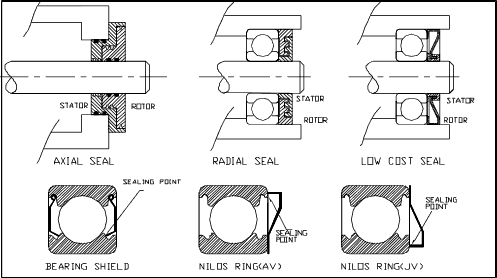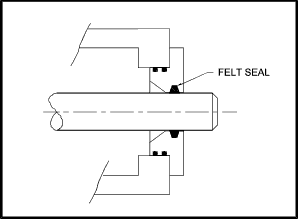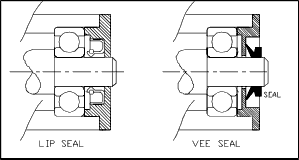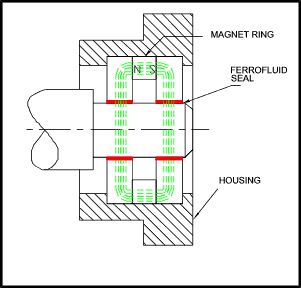|
Introduction
These notes include descriptions of the following seal types.
- Labyrinth Seals
- Felt Seals
- Lip Seals
- FerroFluid Seals
|
Mechanical Seals are widely used for rotary shaft seals these are reviewed
on another page Mechanical Seals
Labyrinth Seals
A labyrinth is defined as a complicated network of passages. A
labyrinth is provided to prevent the easy passage from the entry to the exit.
The labyrinth seal provides
the same function. The Labyrinth Seal restricts the passage of solid, liquid and gaseous contaminants into the sealed area
and also restricts the leakage of fluid out of the sealed containment.
Non-contacting rotary and stationary elements provide a restricted flow path and
utilize centrifugal force and gravity to prevent leakage.
Unlike other rotating e.g lip seals, the Labyrinth Seal will not damage shafts and has a virtually
unlimited life, is frictionless, is largely unaffected by high or low temperatures and can be used for
high shaft rotating speeds.
Sealing depends on the form of the labyrinth gap and the length of the leakage path.
Rings on the shaft and grooves in the housing provide the basic labyrinth.
At least three groves should be used to provide adequate sealing; clearances vary
between 0.25 to 1.0 mm, depending on the speed and temperature the seal is
operating in.
More efficient forms of labyrinth seal use
alternating teeth of alternating serrations. Smaller gaps produce less leakage but
the gap has to be large enough to avoid contact.
The obvious disadvantage of the labyrinth seal is that there is an engineered gap.
This type of seal does not work well if the shaft is not rotating and is not really effective at
sealing across high pressure differentials.

Labyrinth Seal Variations
Felt Seals
Felt seals are mainly used as oil or grease seals for retaining lubrication
and at the same time preventing dirt or dust entering the bearing.
Felt has long been used for sealing duties because of numerous favourable
properties such as wicking and oil absorption properties, fine filtering and
resilience. This allows the felt to maintain a constant sealing pressure and as
the seal wears the felt surface remains unchanged.
Felt seals are usually pre-saturated with lubricants of a higher viscosity than
the bearings offering positive bearing protection. If the seal does
run dry it will tend to protect and polish the shaft rather than cause damage.
Through normal operating temperatures and conditions the felt seal is highly
economical, normally requiring replacement when the machine is overhauled.
When the seal is correctly installed the seal is effective over a variety of
operating conditions and a wide range of speeds.
Normal maximum rubbing speed is 10 m/s but can be as high as 20m/s if the rubbing
surfaces are highly polished and lubricant is always present.
Felt Seals
are not suitable for oils with extremely low viscosity or the lubricant is pressurised.

Felt Seal
Lip Seals
This is an assembly consisting of a rubbing elastomer ring seal element held
in place by spring. The seal friction is reduced as an oil film is
generated between the lip of the seal and the shaft. Any damage to the
shaft where the seal runs will cause leakage because the optimum oil film thickness
will be exceeded locally. Therefore the shaft finish is especially
important, as leakage will occur if an irregular surface is present.
The lubricated rubbing provides the sealing action. This sealing action cannot be maintained
at high speeds if the shaft is not running perfectly true.
To maintain oil film thickness the seal must follow any shaft movement.
This becomes difficult when the shaft is subject to eccentric running or vibration
at high speeds. Typically these seals will operate in the region of
18 m/s and the seals are affected by friction.

Lip Seal
Ferrofluid Seals
This is a very specialised rotary seal type which has superior theoretical benefits.
The seal is a fluid ring which is retained in place between the rotating and fixed members under the action of magnetic forces.
Ferrofluidic sealing technology takes advantage of the response of a
fluid, containing a uniform distribution of magnetic particles, to an applied magnetic field. It uses a magnet with magnetically
permeable north and south pole pieces and a magnetically
permeable shaft to create a permanent magnetic circuit. The magnetic
flux is concentrated in the gap under each pole and when ferrofluid is
applied to this gap it assumes the shape of a liquid o-ring and produces
a hermetic seal.
Ferrofluidic seals offer provide hermetic sealing,
long life, virtually frictionless sealing and smooth
operation. They are non-contaminating, highly reliable and can
operate at high speeds. This type of seal can be used over a wide temperature range, which can
be increased by use of cooling, or heating circuits.
The seals have to be regularly maintained as the fluid properties deteriorate over time.
These bearings are used for very specialised applications.
Ferrofluid Seal

Ferrofluid Seal
Other Types of Rotary Seals
Variations on the themes established above include for brush seals and finger seals.
| 


